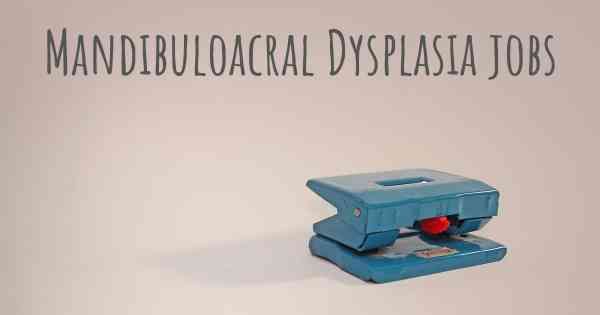Can people with Mandibuloacral Dysplasia work? What kind of work can they perform?
See how people with experience in Mandibuloacral Dysplasia give their opinion about whether people with Mandibuloacral Dysplasia can work and what kind of jobs are more appropriated for people with Mandibuloacral Dysplasia

Can people with Mandibuloacral Dysplasia work? What kind of work can they perform?
Mandibuloacral Dysplasia (MAD) is a rare genetic disorder that affects various parts of the body, including the jaw, skeleton, and skin. It is characterized by skeletal abnormalities, such as underdeveloped or absent collarbones, short stature, and joint deformities. Additionally, individuals with MAD may experience skin changes, such as tight and thin skin, abnormal pigmentation, and loss of fat tissue.
Given the physical challenges associated with MAD, individuals with this condition may face limitations in certain types of work. However, it is important to note that the impact of MAD can vary from person to person, and individuals with MAD can still lead fulfilling and productive lives.
Employment Opportunities for Individuals with Mandibuloacral Dysplasia
While the physical symptoms of MAD may pose challenges in certain occupations, there are various types of work that individuals with MAD can perform, depending on their specific abilities, skills, and interests. It is crucial to focus on their strengths and provide accommodations when necessary to ensure equal opportunities in the workplace.
1. Office-based Jobs: Individuals with MAD can excel in office-based jobs that require cognitive abilities, such as administrative work, data entry, customer service, or bookkeeping. These roles often involve tasks that can be performed while seated, minimizing physical strain.
2. Creative Fields: Many individuals with MAD possess artistic talents and can pursue careers in creative fields such as graphic design, illustration, writing, or photography. These professions often allow for flexible working conditions and can be adapted to accommodate physical limitations.
3. Information Technology: The field of information technology offers a wide range of opportunities for individuals with MAD. They can work as software developers, web designers, or IT support specialists, leveraging their problem-solving skills and attention to detail.
4. Research and Analysis: Individuals with MAD can contribute to scientific research, data analysis, or market research. These roles often involve desk-based work, allowing individuals to utilize their analytical skills and contribute to advancements in various fields.
5. Entrepreneurship: Some individuals with MAD may choose to start their own businesses, allowing them to create a work environment that accommodates their specific needs. Entrepreneurship offers flexibility and the ability to tailor work tasks to individual capabilities.
Importance of Workplace Accommodations
It is crucial for employers to provide reasonable accommodations to individuals with MAD to ensure equal opportunities and a supportive work environment. Accommodations may include flexible work hours, ergonomic workstations, assistive devices, or modifications to physical workspaces.
Conclusion
While individuals with Mandibuloacral Dysplasia may face physical challenges that limit their work options, they can still pursue various careers that align with their abilities and interests. By focusing on their strengths, providing necessary accommodations, and fostering an inclusive work environment, individuals with MAD can lead fulfilling and productive professional lives.








